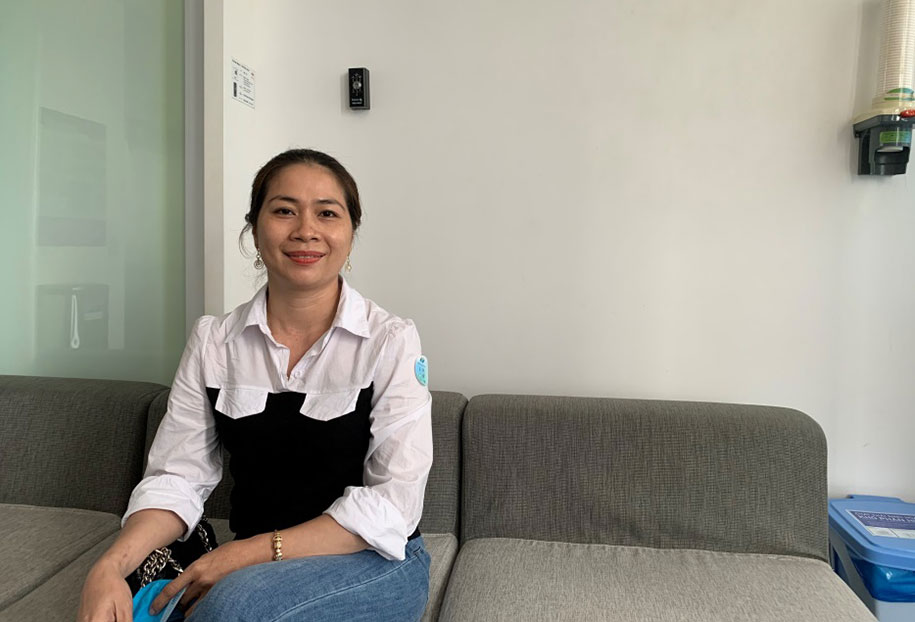Mrs. N. A., who lives in Vinh Long, was diagnosed with venous insufficiency of her left leg. Three or four times a year, her leg and knee joint would swell and she’d experience pain in her lower left abdomen.
“At that time, I thought I had joint disease, and when the lower abdominal pain appeared I thought it was related to an obstetric and gynaecological issue. I had treatment but I didn’t get better.” says Mrs. N. A., 37.
Over a three year period, Mrs. N. A. went to many major hospitals in Ho Chi Minh City for examination and treatment. She was offered intravenous laser surgery, but her condition did not improve. Her number of episodes doubled to six or seven a year and her pain was so acute that Mrs. N. A. felt she had not been properly treated.

After being introduced by a friend, Mrs N.A. visited FV Hospital and met Dr Luong Ngoc Trung at the Vascular Surgery Department. After examination, Dr Trung found that Mrs. N.A.’s clinical symptoms and ultrasound images did not indicate varicose veins alone, but suspected that she was experiencing pelvic congestion syndrome.
When conducting a pelvic CT scan, the results showed that the patient had varicose veins of the left ovary, causing pelvic varicose veins. Mrs N.A. also had symptoms of varicose veins in her left leg.
At the beginning of Mrs N.A.’s treatment, Dr Trung indicated to use the internal medicine method. Two months later, Mrs N.A.’s condition improved significantly. The pain in her abdomen had greatly reduced and her legs were no longer swollen. Dr Trung wanted to continue her care by surgical obstruction of the left ovary vein via intravascular intervention. Due to her effective medical treatment so far, Ms. N.A. had great faith in Dr Trung and agreed to the surgery.
The operation, via a single needle puncture in the skin, was performed successfully within an hour in the Cardiovascular Intervention Room (Cathlab) with local anaesthesia. Immediately after intervention, Mrs. N.A. patient could walk freely without needing pain relievers. She was discharged after one day.
“Fortunately, Dr Trung helped me by diagnosing the right illness and I didn’t suffer long-term pain. After visiting a lot of hospitals from my province to Ho Chi Minh City, I just hope that one day my disease will be cured completely,” said Mrs N.A.
“It can be said that Dr Trung is my saviour after treating my illness in just over two months.”
When asked about her experience during examination and treatment, Ms. N.A. added:
“The special thing is that, after going to FV, I do not want to go anywhere else. The team, from doctors to admin staff, and the examination environment and postoperative care are so wonderful that I feel more secure and comfortable undergoing treatment here.”
According to Dr Trung, the intervention procedure to embolise the dilated ovarian vein is minimally invasive and has a short recovery time, and so is preferred in the treatment of pelvic congestion syndrome. A small needle incision is made in the groin area of the thigh, so there is no need for stitches and no scarring. Once the vasodilation has been resolved, the patient no longer has persistent hypotension and their quality of life is improved. A few hours after treatment, the patient can walk and be discharged from the hospital after their follow-up within one day.
In the past, cases of pelvic congestion due to ovarian venous insufficiency misdiagnosed as endometriosis have also been successfully treated at FV. This condition can also occur in men with symptoms of varicose veins.
Dr Luong Ngoc Trung also recommends if women have signs of pelvic congestion syndrome they should see a specialist for early detection and treatment. Symptoms include severe pressure, pelvic pain (lower abdomen), increased pain during menstruation, indications of leg venous insufficiency such as edema, aggravation and cramps.
The disease does not have a clear cause and is easily misdiagnosed with varicose veins of the lower extremities and endometriosis. The disease is one of the causes of infertility in both men and women, and can severely affect a person’s quality of life.

 Vi
Vi 












